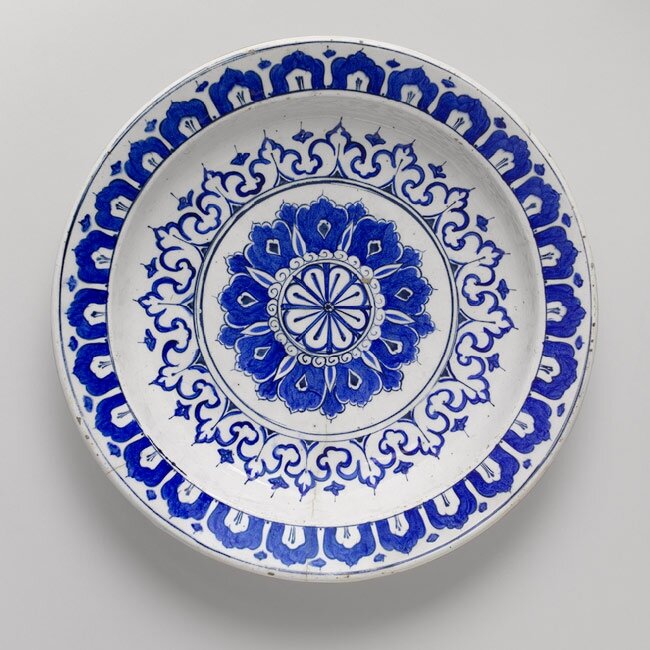Plate, ca. 1580, Iznik, Turkey
Plate, ca. 1580, Iznik, Turkey. Fritware, polychrome painted under a transparent glaze.
This dyamically decorated sixteenth-century dish in cobalt blue was produced at the famous kilns at Iznik, in western Anatolia. Stylized variations of lotus petals, ultimately of Chinese inspiration but geometrically patterned into a radiating sunburst of powerful Islamic design, bear witness to one of the most fruitful cultural exchanges in history: the mutual influences flourishing for centuries between the artists, especially potters, of eastern and western Asia. Chinese influences on Islamic art peaked in the thirteenth and fourteenth centuries, when nearly all Asia came under the sway of the Great Khans, the Mongol overlords ruling from Beijing. The Mongol Ilkhans who governed the Near East from their capital at Tabriz, in modern northwestern Iran, imported precious Chinese wares, commanding local Muslim artists to study Chinese technique and design. The sixteenth-century potters of the Ottoman court, though set at the westernmost limit of the Asian world, still pursued—and creatively renewed with great flair and pride—the traditions of the Tabriz school.
(Source)

/https%3A%2F%2Fprofilepics.canalblog.com%2Fprofilepics%2F1%2F0%2F100183.jpg)
/https%3A%2F%2Fstorage.canalblog.com%2F03%2F02%2F119589%2F96711876_o.jpg)
/https%3A%2F%2Fstorage.canalblog.com%2F11%2F31%2F119589%2F94773502_o.jpg)
/https%3A%2F%2Fstorage.canalblog.com%2F20%2F83%2F119589%2F94772815_o.jpg)
/https%3A%2F%2Fstorage.canalblog.com%2F26%2F72%2F119589%2F75604929_o.jpg)
/https%3A%2F%2Fstorage.canalblog.com%2F59%2F60%2F119589%2F26458628_o.jpg)



/http%3A%2F%2Fstorage.canalblog.com%2F56%2F31%2F119589%2F128568509_o.jpg)
/http%3A%2F%2Fstorage.canalblog.com%2F63%2F14%2F119589%2F122505856_o.jpg)
/http%3A%2F%2Fstorage.canalblog.com%2F26%2F89%2F119589%2F112641742_o.jpg)
/http%3A%2F%2Fstorage.canalblog.com%2F20%2F70%2F119589%2F110137002_o.jpg)